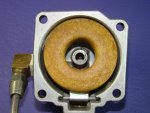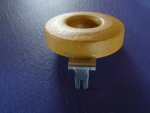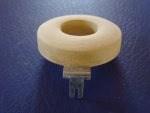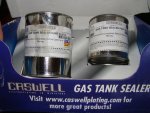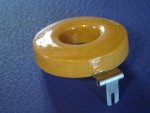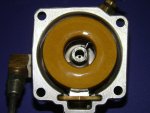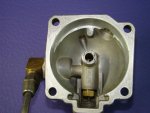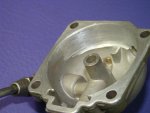Armada
New member
- 3,046
- 4
- 0
- Location
- Buick City, MI
Thought I'd pass along a fix for fuel logged float problems so that it may save someone else some frustration.
I put a new 4a032 crate engine on an mep-016 genset and it ran fine, for about a week. I started having problems with the engine flooding after start up. I removed the bowl on the carb and found the float was saturated with fuel and sticking to one side of the bowl. After some research, I found others had the same problem primarily caused by ethenol enriched fuel but with no clear fixes other than modifying a similar float from different material.
To start with, I decided to modify the bowl instead of the float. I used a dremmel which worked nicely for clearancing the bowl. The bowl casting is plenty thick, even after cutting. No problems with a sticking float now.
Next was how to keep the float from absorbing fuel without loosing it's bouyancy. I used a product called Caswell fuel tank sealer. Its a 2 part epoxy that is impervious to fuel, including ethenal. I've lined small tanks with it before and have never had an issue. Thought I'd try it on a float this time. First I completely dried the float then lightly sanded and cleaned it. I mixed the 2 parts of sealer and applied one coat to the float. After a 24 hour cure time, it was ready to go back in the carb. The surface of the float is completely sealed now and hard as nails. Float bouyancy did not change. After installing the carb back on the engine it fired up and has been fine since. The float's been soaking in fuel for the last week or so now and no flooding problems yet. I don't expect any either, as I've seen fuel tanks with the Caswell epoxy lining that have been immersed in fuel for a couple years with absolutely no degredation. Hope this helps someone else experiencing the same problem with the military standard engine floats.
Anyways, here are some pictures. They will do a better job of 'painting a picture' than my typing will.
I put a new 4a032 crate engine on an mep-016 genset and it ran fine, for about a week. I started having problems with the engine flooding after start up. I removed the bowl on the carb and found the float was saturated with fuel and sticking to one side of the bowl. After some research, I found others had the same problem primarily caused by ethenol enriched fuel but with no clear fixes other than modifying a similar float from different material.
To start with, I decided to modify the bowl instead of the float. I used a dremmel which worked nicely for clearancing the bowl. The bowl casting is plenty thick, even after cutting. No problems with a sticking float now.
Next was how to keep the float from absorbing fuel without loosing it's bouyancy. I used a product called Caswell fuel tank sealer. Its a 2 part epoxy that is impervious to fuel, including ethenal. I've lined small tanks with it before and have never had an issue. Thought I'd try it on a float this time. First I completely dried the float then lightly sanded and cleaned it. I mixed the 2 parts of sealer and applied one coat to the float. After a 24 hour cure time, it was ready to go back in the carb. The surface of the float is completely sealed now and hard as nails. Float bouyancy did not change. After installing the carb back on the engine it fired up and has been fine since. The float's been soaking in fuel for the last week or so now and no flooding problems yet. I don't expect any either, as I've seen fuel tanks with the Caswell epoxy lining that have been immersed in fuel for a couple years with absolutely no degredation. Hope this helps someone else experiencing the same problem with the military standard engine floats.
Anyways, here are some pictures. They will do a better job of 'painting a picture' than my typing will.
Attachments
-
71 KB Views: 52
-
48.8 KB Views: 49
-
45.2 KB Views: 51
-
73.2 KB Views: 53
-
58.1 KB Views: 51
-
57.6 KB Views: 54
-
62.2 KB Views: 51
-
42.5 KB Views: 53
Last edited:



